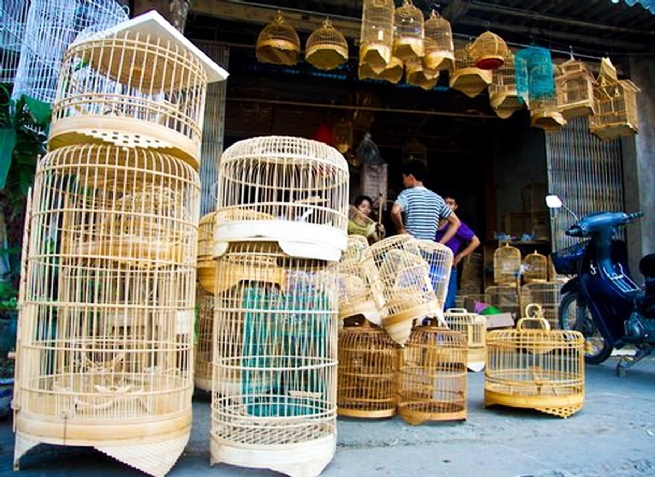Canh Hoach village, also known as Vac village in Dan Hoa commune, Hanoi, is regarded not only as the birthplace of two doctoral laureates but also as a renowned center of traditional birdcage making across Vietnam.

A handed-down craft
In Canh Hoach, most of the village’s exquisite birdcages are entirely handcrafted—a tradition that has lasted for more than a century.
According to village elders, the craft of birdcage making in Vac village (the village’s folk name) dates back generations, passed down from father to son. The craft’s patriarch is considered to be Nguyen Van Ty, who lived in the 19th century. He passed the trade to his son, Nguyen Van Nghi, known by the artisan name Ba Mi. His grandson, Nguyen Van Nghe, became the first in the village to be honored as a craft artisan.
Nghe also set a record with a birdcage measuring 2.7 meters high and 0.9 meters wide, winning Third Prize in a Hanoi birdcage-making competition in 2011. Birdcages from Vac village had already won medals at expositions in Hanoi during the French colonial era.
According to Nghe, producing a high-quality birdcage that meets the standards of durability, beauty, and refinement requires dozens of meticulous steps, including oiling, shaving bamboo slats, shaping the base, rims, doors, perches, decorating, and assembling. The most challenging stage is carving patterns on the rims. Using only a small knife, Canh Hoach artisans create intricate motifs such as flying dragons, dancing phoenixes, and the symbolic four seasons of pine, chrysanthemum, bamboo, and apricot blossoms, turning each cage into a vivid work of art. Today, despite competition from birdcages imported from China and Taiwan, Vac village products still hold a special place among ornamental bird enthusiasts. Beyond birdcages, artisan Nghe has applied these techniques to produce fine lanterns, which have been exported to markets including France, Thailand, and Malaysia.
Younger artisans are not only preserving the craft but also innovating—creating new cage shapes such as round, square, domed, tower, and hexagonal forms to match domestic and international tastes. Many households have expanded sales through social media, bringing their products to customers in other provinces and even overseas.

Economic value of the craft
The diversity and artistry of Canh Hoach’s birdcages not only meet the refined tastes of Vietnamese bird enthusiasts but also generate sustainable income for local families.
At the workshop of Nguyen Huy Tuan, one of the village’s well-known fine-art birdcage makers, five to seven workers are employed regularly. He explained that producing a birdcage involves dozens of important steps, with support from machines such as saws, grinders, drills, and dust collectors.
“To meet the demands of discerning bird keepers, a cage must be perfectly straight, evenly colored, tightly fitted, and made from absolutely dry bamboo or rattan, with the outer layer preserved during shaving,” Tuan said.
Prices vary depending on materials and customer preferences. Mass-produced cages are priced from just tens of thousands to a few hundred thousand VND each. However, fine-art cages command much higher prices. With the growing popularity of bird contests and exhibitions, a beautiful cage has become essential. Many customers from Ho Chi Minh City travel directly to the village to place high-end orders. Although each household produces only three to five cages per day, prices range from VND7 million to VND20 million per piece, providing substantial earnings.
To support the craft village, the Dan Hoa Commune People’s Committee has introduced training courses for young workers, assisted with registering a collective trademark, and connected artisans with enterprises and cooperatives to expand production.
Dinh Huu Binh, Chairman of the Dan Hoa Commune People’s Committee, emphasized: “Our goal is to develop traditional craft villages, including Canh Hoach birdcage making. This is not only about preserving heritage but also about creating sustainable livelihoods for local people.”
By Minh Ngoc, Vietnam Business Forum
| This special section is supported by Hanoi Coordination Office of the New Rural Development Program |